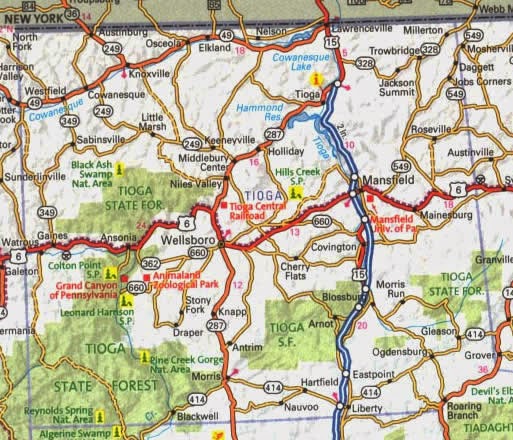It’s About More than Following the “Blue Line”
28 Second Takeaway:
While
the GPS is an extremely efficient tool in helping us get to where we are going, a good old paper map allows us to see the big picture. This is true in business as
well. If we only rely on the technology and management tools, we’ll stay
focused on the “blue line” rather than looking at the bigger opportunities that
might be out there.
 On our driving trip across the country I have found myself in places I
have never driven through – eastern Ohio, upstate New York and western
Massachusetts. In these situations, I have found that Google Maps on my phone is
an invaluable tool. No more squinting at a map, trying to understand if I
should take I-77 or Ohio 8 to get to Canton (FYI: we are on the Russell family Hall of Fame tour –
pro football in Canton, basketball in Springfield, MA, the Patriots HOF for Ben in
Foxboro, and the Baseball HOF in Cooperstown).
On our driving trip across the country I have found myself in places I
have never driven through – eastern Ohio, upstate New York and western
Massachusetts. In these situations, I have found that Google Maps on my phone is
an invaluable tool. No more squinting at a map, trying to understand if I
should take I-77 or Ohio 8 to get to Canton (FYI: we are on the Russell family Hall of Fame tour –
pro football in Canton, basketball in Springfield, MA, the Patriots HOF for Ben in
Foxboro, and the Baseball HOF in Cooperstown).
But there are situations where I have questioned the information I am getting from
my phone. "Wow, that doesn't seem like the easiest way to get there. Are we
taking side roads where we will get stuck in traffic or interstates?" I know
that the GPS will, in fact, get me to my destination, but I am unclear on the big
picture of where I am going. All I know is that if I turn left or right and stay on the blue line things will all be good.
Or will they?
Throughout the trip, Lisa and I have found ourselves conferring with both Apple Maps and
Google Maps - plugging addresses into multiple phones - and they sometimes
provide different answers. And because I am a just a bit old school, I bought a
good old Road Atlas at the I-80 truck stop early in our journey.
After the 22 hours we spent in the car this week, I have spent some time
thinking about the difference between the GPS on my smartphone and the paper map. I think the distinction between the two tools have applicability in the rest of our lives as
well.
The GPS has incredible smarts built into it. It knows the traffic on
various roads and can route you around traffic jams. It will sometimes let you know alternate
ways that may be faster (or slower). It reads the directions to you so you can keep
your eyes on the road. In many ways, the GPS is superior to the paper map
that you have to decipher, refer to as you drive and provides no additional
data. Except the paper map is superior in one way – it lets you easily see the
big picture. You can see one state, multiple states, even the entire country at
a glance. You can follow a road all the way to the destination easily. Sure the phone has that capability if you keep swiping out far
enough, but that isn't the strength of a GPS.
In some ways managing our businesses can be like the GPS – we have
metrics and dashboards, tools and techniques. But if we don’t have a map, it is
easy to lose sight of the big picture. Just stay on the blue line. Don’t worry about the
rest – someone else is looking at that, right?
I believe that an essential part of leadership is backing all the way
up and seeing the biggest picture possible. Not that it is always clear,
because it isn't. But thinking about the journey – which way will be the best,
which way can we navigate the easiest, even what is our preference – is something
leaders need to do on a regular basis.
I noticed that sometimes Google Maps will put me on an obscure route
because it is one minute faster, even though it may mean a smaller road. In one
situation, Apple Maps took me a back route to a restaurant and Google wanted me to take the
main road. In another situation, I Googled a restaurant and it sent me to a location 10 minutes away rather than the one I had just passed. Without knowing where I was going, I followed the map, only to realize that I had arrived at precisely the wrong place. The GPS has no judgment beyond what is programmed - when we stopped for gas, it thought we took a wrong turn rather than just a temporary stop on the journey to our destination.
The ability to see this broader context is what maps, and our own judgment, allow us to do better
than the GPS. In business, it is what leaders must do. Focus on the context and
explain the way forward. Technology and management tools can make sure we get there in the fastest, most efficient way. But in business,
like in navigation, only our judgment can make the decision about the best
course for us.
It isn't always easy with either tool. Sometimes you find yourself at a
fork in the road and needing to make a decision – left or right. A combination
of the tools is helpful. The map can let you see many miles down the road in a
quick glance – where is the road taking us? The GPS knows the route you originally
set and can reroute you if you took a wrong turn. Sometimes I found myself overriding
the GPS because I could see another way might be better – we might drive by
something interesting, we might have to take fewer turns or maybe there was a
rest stop that was desperately needed.
I was talking with someone awhile back about the wonders of Google Maps and mentioned that our kids will
never be lost. Plug an address into the phone and follow the blue line. Don't worry about the roads and the way, because you can just follow the blue line. In someways, I think
that is a shame – while I hate being lost, some of the most interesting things
happen while you are lost. And importantly, you learn what caused you to be
lost – what mistake you made and hopefully how not to make the same mistake
again. It also concerns me that our children might learn to just follow the blue
line – suspending their own logic and judgment.
In business, we need team members at all levels that want to look at the
map. It is important to know that on a day-to-day basis, we generally are following the blue line (the
course we have plotted out). I believe alignment is critical in an organization (do we all know where we are going – is it New York or California?). We need to know the
best way to get there, but we also need people who are continually looking at
the map and suggesting that if we took a slightly different road that we might
find a new opportunity, get there a bit faster or enjoy the ride a bit more.
That doesn't happen if all we do is follow the blue line blindly.
So from the road, I offer these suggestions:
- Make sure you are taking a look at the map frequently. Are you still headed where you thought you were? Is it still the place you want to go?
- Use the tools and technology to go where you want, not allow the tools to drive where you are headed.
- Chart your own path – often a few small deviations will make the trip that much better.

Comments
Post a Comment